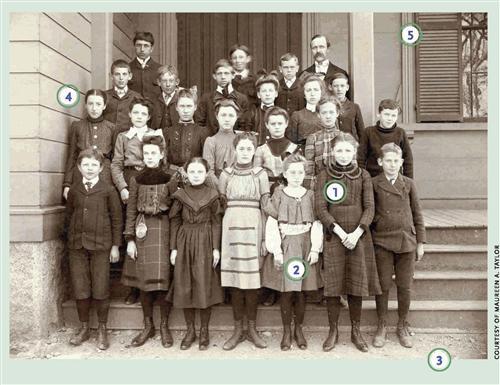Sign up for the Family Tree Newsletter Plus, you’ll receive our 10 Essential Genealogy Research Forms PDF as a special thank you!
Get Your Free Genealogy Forms
"*" indicates required fields

If you’ve had kids, you know the drill: Every fall or spring, your child would come home with an order form for school portraits. You’d pin some money inside your little one’s backpack and several weeks later, he’d trot home clutching the photos. School photos go back to the early days of photography when, in 1840, Yale class of 1810 alumni posed for the camera.
Some school images are easily confused with photographs from events such as weddings. For instance, in the late 19th and early 20th centuries, young women dressed in white for graduations. A rolled-up diploma indicates a photo of an ivory-gowned woman isn’t a bridal portrait.
If your photo collection has a class picture like this one, an ancestor is probably standing among those cute kids. But which one is he (or she)? Here’s how to earn an A+ in school-photo research.
Cheat sheet
To make an ancestral ID, you’ll need to learn when and where the picture was taken. You may be able to take the easy way out: Turn over your picture to see if it’s labeled with the school name, a date and names of anyone in the picture. Some of our ancestors made marks above their own heads on class portraits. In the case of this picture, someone identified several students for a town scrapbook; a relative might have put names on your photo.
Style school
No luck? Assign your photo a date by figuring out when the clothing styles were popular. Here, the girls’ dresses have high collars and fitted sleeves, and several in front sport frocks with trim. Compare these key aspects of their outfits to the fashion plates in JoAnne Olian’s Children’s Fashions 1860-1912 (Dover Publications) and Kristina Harris’ The Child in Fashion: 1750-1920 (Schiffer Publishing Co.). The dresses and suits shown here date from around 1901 and would’ve cost their parents from $2 to $4 each, according to Children’s Fashions 1900-1950 as Pictured in Sears Catalogs edited by Olian (Dover Publications).
Age gap
Combine the fashion facts with what you know about child development to guess the ages of children in a picture. Skirt and pants length can help: To allow for more active play, little boys wore short pants and girls wore calf-length skirts. Boys and girls started wearing longer pants or skirts about age 12. Based on their outfits and their appearances — ranging from baby faces to the more mature look of adolescence — they’re probably 10 to 12 years old.
Geography lessons
Now that you’ve estimated a date for the picture, do some local history research into schools near your ancestors’ hometowns at the time. If you don’t know where they lived, try using census records. Though it’s more of a long shot, the school building may give you location clues, too: Schoolhouses reflected whatever architectural design was in vogue when and where they were constructed — a one-room adobe schoolhouse is a hint the picture wasn’t taken in New England. You can compare your photo to historical images of schools around the country in the Library of Congress’ American Memory online collection <memory.loc.gov>; just type school into the search box. See the August 2006 Family Tree Magazine Photo Detective column for resources on deciphering architectural details in your pictures.
Multiple choice
Fetch your family group sheets for ancestors who lived near the school, and use the process of elimination: Obviously, if you’re looking for a female ancestor, you can remove boys from consideration. Then find children about the age your relative was at the time of the photo. Finally, compare them to known pictures of your relative. Enlarge the photos and study the eyes, ears and noses — features that change less over time.
Add to the story of your ancestor’s youth by seeking school records, such as class rosters, report cards and yearbooks (which may have additional photos); see the October 2005 Family Tree Magazine for a primer on finding these records. Now go to the head of the class.
Tales Out of School
1. Dressed for success. High collars and fitted sleeves like these were stylish around 1901.
2. Life stages. Younger children wore shorter skirts or pants.
3. Closed captioning. Look for names and dates on the back of the picture.
4. Look-alikes. Compare the students to photos of your relatives.
ADVERTISEMENT

